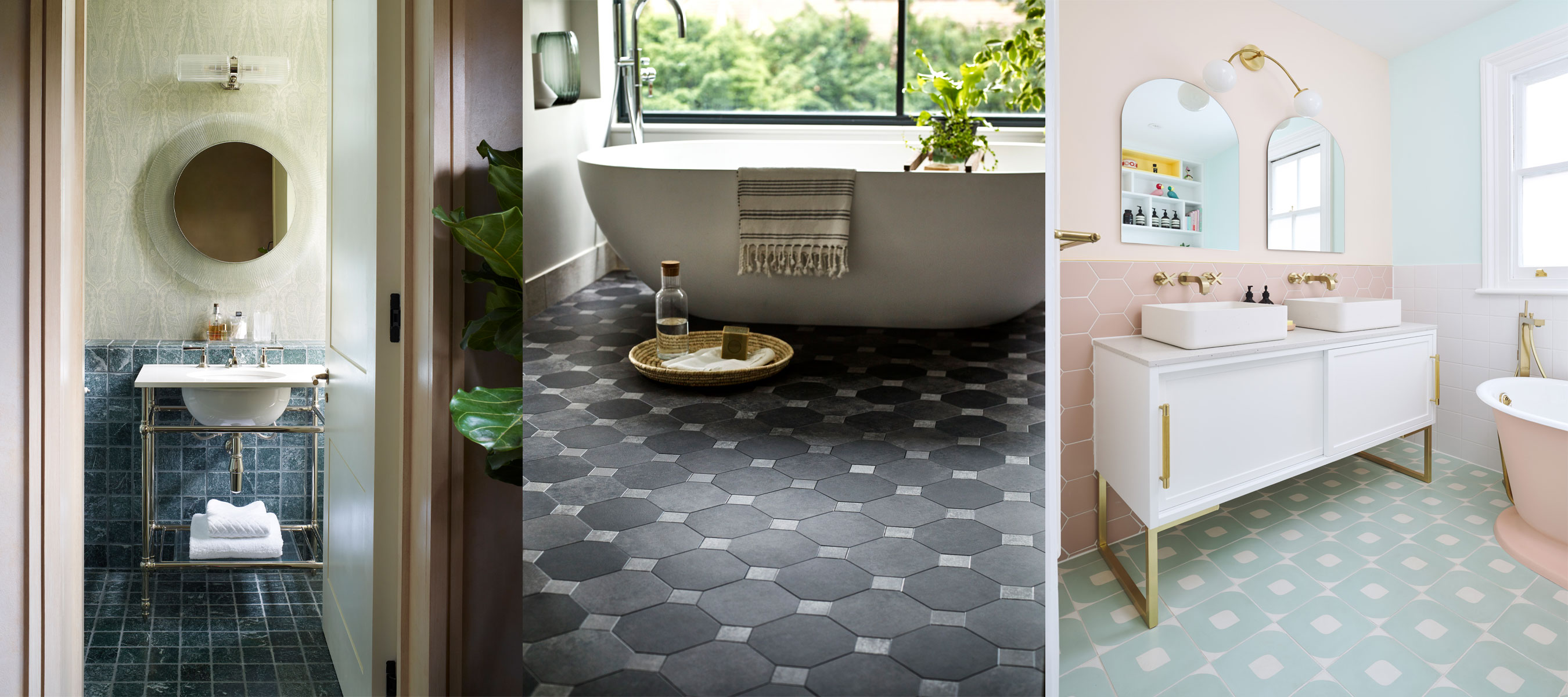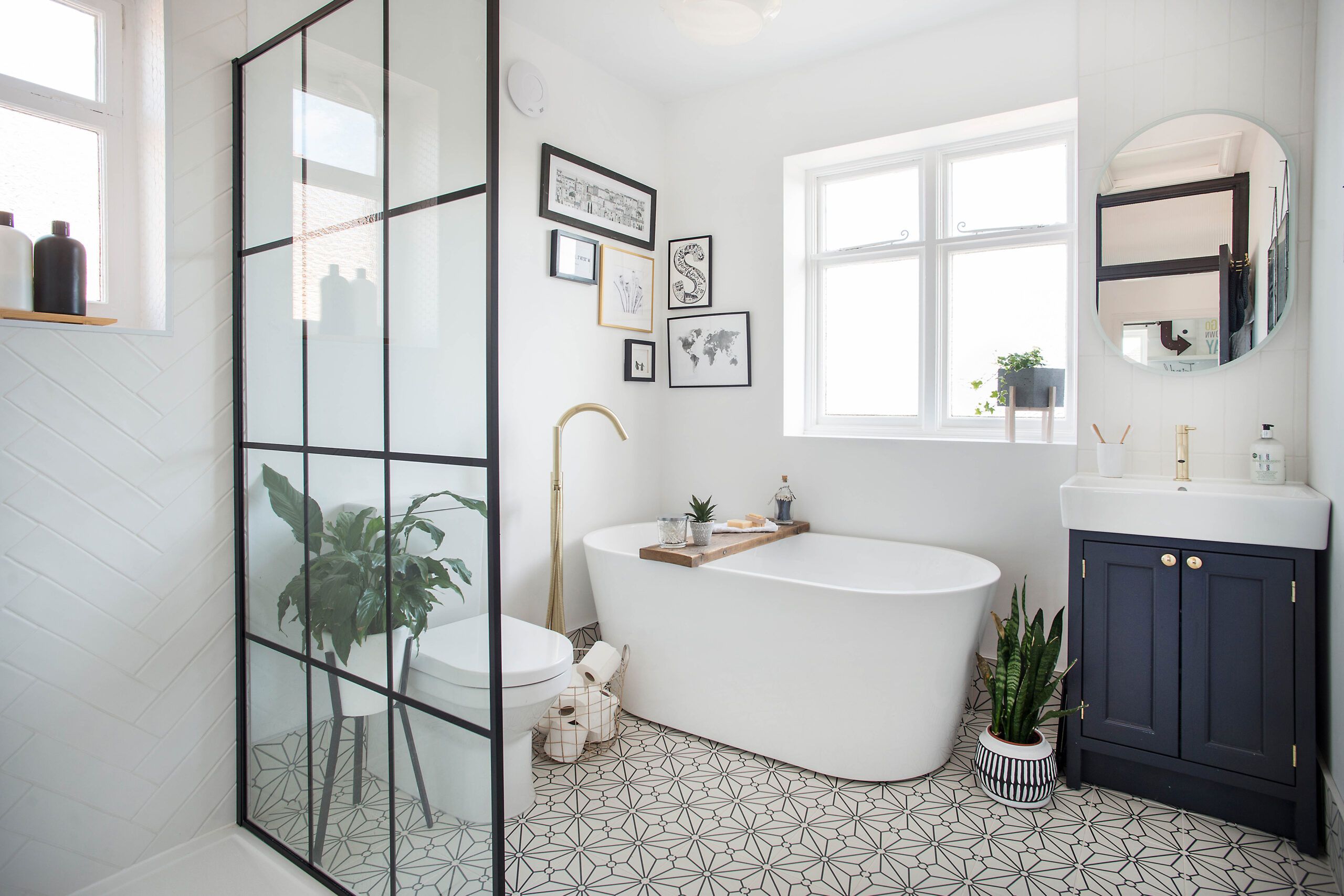Small Bathroom Flooring: Bathroom Flooring Ideas Small Bathroom

Choosing the right flooring for a small bathroom is crucial. Not only does it need to be durable and water-resistant, but it should also enhance the space’s aesthetic appeal. With various options available, understanding the pros and cons of each material is essential to make an informed decision.
Ceramic Tile
Ceramic tile is a popular choice for bathrooms due to its durability, water resistance, and affordability. It’s available in a wide range of colors, patterns, and sizes, making it easy to find a style that complements any bathroom decor.
- Durability: Ceramic tile is known for its durability and resistance to scratches, dents, and wear and tear. It can withstand heavy foot traffic and the weight of furniture.
- Water Resistance: Ceramic tile is naturally water-resistant, making it ideal for wet areas like bathrooms. It’s also easy to clean and maintain, as spills and splashes can be wiped away easily.
- Maintenance: Ceramic tile requires minimal maintenance. Regular sweeping and mopping are sufficient to keep it clean. However, grout lines can accumulate dirt and grime over time, requiring occasional cleaning with a grout cleaner.
- Aesthetics: Ceramic tile offers a wide range of styles, from classic to modern. It can be used to create intricate patterns or simple, minimalist designs. Its versatility allows for a personalized touch in any bathroom.
Porcelain Tile, Bathroom flooring ideas small bathroom
Porcelain tile is a denser and more durable type of ceramic tile. It’s known for its high water resistance, scratch resistance, and stain resistance.
- Durability: Porcelain tile is even more durable than ceramic tile, making it an excellent choice for high-traffic areas. It’s resistant to scratches, dents, and chips, ensuring a long-lasting surface.
- Water Resistance: Porcelain tile is highly water-resistant, making it suitable for bathrooms, kitchens, and other wet areas. It’s also resistant to moisture damage, preventing mold and mildew growth.
- Maintenance: Porcelain tile requires minimal maintenance. Regular sweeping and mopping are sufficient to keep it clean. Grout lines should be cleaned periodically with a grout cleaner to prevent dirt buildup.
- Aesthetics: Porcelain tile offers a wide range of styles, including sleek and modern designs. It can be used to create a sophisticated and elegant look in any bathroom.
Vinyl Plank
Vinyl plank flooring is a popular alternative to tile, offering a similar look with added comfort and ease of installation. It’s known for its water resistance, durability, and affordability.
- Durability: Vinyl plank flooring is durable and resistant to scratches, dents, and wear and tear. It can withstand heavy foot traffic and the weight of furniture.
- Water Resistance: Vinyl plank flooring is water-resistant, making it suitable for bathrooms. It’s also resistant to moisture damage, preventing mold and mildew growth.
- Maintenance: Vinyl plank flooring is easy to clean and maintain. Regular sweeping and mopping are sufficient to keep it clean. It’s also resistant to stains, making it a practical choice for bathrooms.
- Aesthetics: Vinyl plank flooring comes in a variety of styles, including wood-look planks, stone-look planks, and solid colors. It can be used to create a warm and inviting ambiance in any bathroom.
Natural Stone
Natural stone flooring, such as marble, granite, and slate, adds a touch of elegance and sophistication to any bathroom. It’s known for its durability, water resistance, and unique beauty.
- Durability: Natural stone is a durable material that can withstand heavy foot traffic and the weight of furniture. It’s resistant to scratches, dents, and chips, ensuring a long-lasting surface.
- Water Resistance: Natural stone is naturally water-resistant, making it suitable for bathrooms. It’s also resistant to moisture damage, preventing mold and mildew growth.
- Maintenance: Natural stone requires regular cleaning and sealing to maintain its beauty and durability. It’s also susceptible to staining, so spills should be cleaned up promptly.
- Aesthetics: Natural stone offers a wide range of colors, patterns, and textures, adding a unique touch to any bathroom. It can be used to create a luxurious and sophisticated ambiance.
Small Bathroom Flooring Material Comparison
| Material | Price Range | Lifespan | Suitability for Small Spaces |
|---|---|---|---|
| Ceramic Tile | $2-$10 per square foot | 20+ years | Excellent |
| Porcelain Tile | $3-$15 per square foot | 25+ years | Excellent |
| Vinyl Plank | $2-$5 per square foot | 10-20 years | Good |
| Natural Stone | $5-$20 per square foot | 30+ years | Good |
Visual Enhancement

Flooring plays a crucial role in shaping the visual appeal and perceived size of a small bathroom. By strategically choosing colors, patterns, and tile formats, you can create a sense of spaciousness and enhance the overall aesthetic.
Light-Colored Flooring: Expanding the Visual Space
Light-colored flooring, such as white, cream, or light gray, can effectively create an illusion of a larger space. The light hues reflect more light, making the bathroom appear brighter and more expansive. This effect is particularly noticeable in bathrooms with limited natural light.
Large-Format Tiles: A Sense of Spaciousness
Large-format tiles, typically measuring 12 inches or more, can visually enlarge a small bathroom. The fewer grout lines created by these tiles contribute to a cleaner and more seamless look, making the space appear larger and more unified.
Patterns: Adding Visual Interest Without Overwhelming the Space
Incorporating patterns into small bathroom flooring can add visual interest and depth without overwhelming the space. Stripes, especially horizontal ones, can create a sense of width and openness. Geometric designs, such as subtle checkerboards or tessellations, can also enhance the visual appeal without making the space feel cramped.
For a small bathroom, it is recommended to choose patterns that are subtle and not overly busy.
Functionality and Safety
In a small bathroom, every square inch counts, and flooring plays a crucial role in maximizing both functionality and safety. Choosing the right flooring material can transform your bathroom from a cramped space into a haven of comfort and practicality.
Slip Resistance
Slip resistance is paramount in any bathroom, but it’s especially critical in small bathrooms where space constraints can make it easy to lose your footing. Wet floors pose a significant safety hazard, so selecting a flooring material with a high slip resistance rating is essential.
- Porcelain and ceramic tiles are often the preferred choice for bathrooms due to their durability, water resistance, and wide range of slip-resistant finishes. Look for tiles with a high coefficient of friction (COF), which measures the resistance to slipping.
- Natural stone, such as slate or granite, can also offer good slip resistance, but it’s crucial to choose honed or textured finishes over polished surfaces.
- Vinyl flooring is another popular option for bathrooms, as it’s typically available in slip-resistant finishes. Look for vinyl tiles with a textured surface or a high COF rating.
Water Resistance
Water is an inevitable part of bathroom life, so choosing a flooring material that can withstand moisture is crucial. Water damage can lead to warping, mold growth, and structural issues, compromising the longevity of your bathroom.
- Ceramic and porcelain tiles are highly water-resistant and impervious to moisture, making them ideal for bathroom floors.
- Vinyl flooring is also water-resistant and often comes with a waterproof core, making it a suitable option for bathrooms.
- Natural stone, while generally durable, can be susceptible to water damage if not properly sealed. Ensure you choose a stone that is specifically designed for wet areas and is sealed regularly to prevent moisture absorption.
Easy Cleaning and Maintenance
In a small bathroom, maintaining cleanliness is essential. Choosing a flooring material that is easy to clean and maintain will save you time and effort in the long run.
- Ceramic and porcelain tiles are relatively easy to clean and maintain, as they can be swept, mopped, and even scrubbed without damage.
- Vinyl flooring is also easy to clean and maintain, as it’s typically resistant to stains and spills. Simply sweep or mop with a mild detergent to keep it looking its best.
- Natural stone can be more challenging to maintain, as it requires regular sealing to prevent stains and water damage.
Flooring Textures and Functionality
The texture of your bathroom flooring can significantly impact its functionality and safety. While smooth surfaces might seem appealing, they can be slippery when wet, posing a safety risk.
- Textured surfaces, such as tiles with a rough finish or vinyl tiles with a raised pattern, offer better traction and reduce the risk of slipping, particularly in wet conditions.
- Smooth surfaces, while aesthetically pleasing, can be slippery, especially in a small bathroom where space is limited. If you opt for smooth flooring, consider using non-slip mats or rugs in high-traffic areas to enhance safety.
Practical Tips for a Safe and Functional Bathroom Floor
- Choose a flooring material with a high slip resistance rating, especially in areas prone to water splashes, such as the shower or tub.
- Ensure the flooring material is water-resistant or waterproof to prevent moisture damage and mold growth.
- Opt for a flooring material that is easy to clean and maintain, as regular cleaning is essential in a small bathroom.
- Consider using non-slip mats or rugs in high-traffic areas to enhance safety and prevent slips and falls.
- Avoid sharp edges or uneven surfaces, as these can pose tripping hazards.
- Use a grout sealant on tiled floors to prevent moisture from seeping into the grout and causing damage.
